Discover a lush tropical paradise with vibrant vegetation, pristine beaches, and authentic Maldivian culture in the southern Gaafu Alifu Atoll
Located in the Gaafu Alifu Atoll in the southern Maldives, Villingili Island offers visitors an authentic glimpse into traditional Maldivian island life in one of the country's most pristine and remote regions. This peaceful island maintains its natural beauty and cultural heritage while providing access to some of the Maldives' most spectacular marine environments.
What makes Villingili special is its lush tropical vegetation and exceptional biodiversity. Unlike many smaller Maldivian islands, Villingili features dense greenery, including large banyan trees, coconut palms, and tropical fruit trees that create a verdant paradise. The island's larger size and natural freshwater lakes contribute to this unique ecosystem, making it one of the most naturally beautiful inhabited islands in the southern atolls.
Visitors to Villingili are drawn by its pristine beaches, exceptional snorkeling opportunities, lush landscapes, and chances to engage with local culture. The island's remote location in the southern Maldives means fewer tourists and a more authentic experience, while its natural environment offers diverse activities both on land and in the surrounding waters.
Villingili Island is situated in the southern part of the Maldives in Gaafu Alifu Atoll (North Huvadhu Atoll), approximately 390 kilometers south of Male. This remote location in the deeper southern atolls provides a more pristine and less-visited environment compared to islands closer to the capital.
Its position within Gaafu Alifu Atoll offers access to some of the Maldives' most spectacular diving and snorkeling sites, with healthy coral reefs and abundant marine life. The southern atolls are known for their exceptional biodiversity both above and below the water.
Villingili Island stands out among Maldivian islands for its exceptional natural environment, featuring lush vegetation, natural freshwater lakes, and diverse ecosystems that create a verdant paradise in the middle of the Indian Ocean.

Villingili features unusually dense vegetation for a Maldivian island, with towering banyan trees, breadfruit trees, coconut palms, and tropical flowering plants creating a lush landscape.

The island contains natural freshwater lakes, a rare feature in the Maldives, which support unique ecosystems and contribute to the island's lush environment.
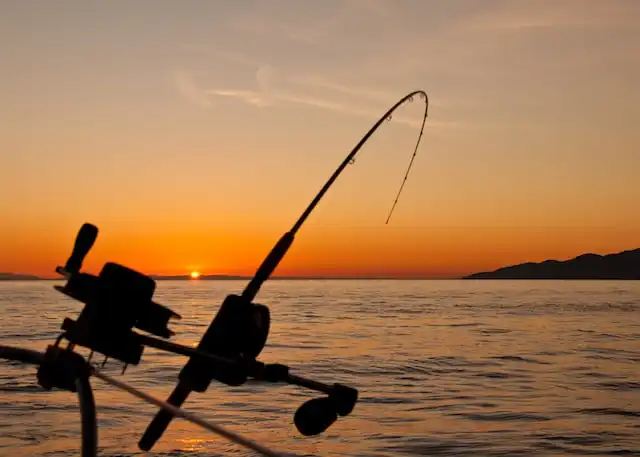
The island's community maintains traditional fishing practices that have sustained residents for generations, providing both food and economic stability.
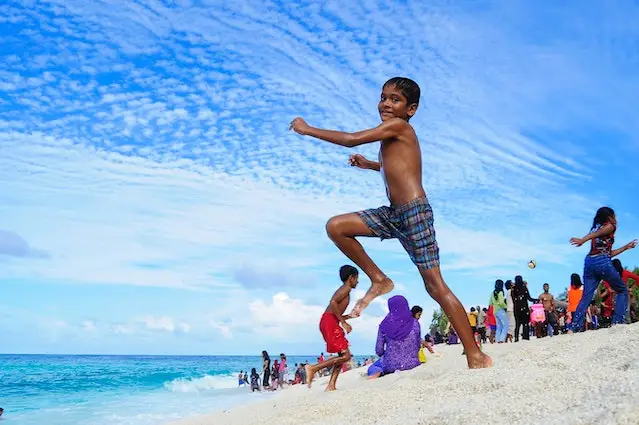
Villingili is home to a vibrant community that has adapted to life in this remote southern atoll while maintaining strong cultural traditions and sustainable practices.
Villingili's exceptional natural environment includes:
These natural elements create a unique island environment that differs significantly from the smaller, less vegetated islands common in the northern atolls.
The Villingili community maintains several sustainable practices:
These practices have helped maintain the island's natural beauty and biodiversity while supporting the local community.
Villingili offers a range of accommodation options that focus on authentic experiences and local hospitality. The island's guesthouses provide comfortable stays while maintaining strong connections to the local community and natural environment.

Several family-operated guesthouses offer clean, comfortable accommodations with personal service. These properties feature air-conditioned rooms with private bathrooms, home-cooked Maldivian meals, and direct access to local knowledge through host families.
Price Range: $50-90 per night
Features: Authentic hospitality, cultural insights, local excursion arrangements

A few boutique-style guesthouses offer enhanced amenities while maintaining a connection to the island's natural environment. These properties feature garden settings, comfortable rooms, and personalized service for a more refined local island experience.
Price Range: $80-150 per night
Features: Garden settings, enhanced amenities, personalized service

Some properties offer beachfront locations with direct access to the island's beautiful shores. These accommodations provide stunning ocean views and the soothing sounds of waves, creating a peaceful environment for those seeking proximity to the sea.
Price Range: $70-120 per night
Features: Beach access, ocean views, water sport facilities
Villingili is blessed with pristine beaches and a spectacular marine environment. The island's remote location in the southern atolls ensures the surrounding reefs remain in excellent condition, offering fantastic snorkeling and marine encounters.
Villingili features stunning white sand beaches that encircle much of the island. The eastern beach is particularly impressive, with powdery sand and crystal-clear turquoise waters that create postcard-perfect vistas. The western beach offers a more sheltered environment, with calm waters ideal for swimming.
The island has a designated "bikini beach" where tourists can wear Western-style swimwear. This beautiful stretch of sand provides a relaxing environment while respecting local cultural norms. The remaining beaches require modest dress as they are used by the local community.
Villingili's vibrant house reef is accessible directly from shore, featuring healthy coral formations and abundant marine life. The reef's accessibility makes it possible to enjoy multiple snorkeling sessions throughout the day without needing boat transportation.


The waters around Villingili Island offer exceptional marine biodiversity:
Gaafu Alifu Atoll is known for its exceptional marine biodiversity and healthier coral systems compared to some northern atolls, making Villingili an ideal base for underwater exploration.
Villingili offers a diverse range of activities that blend natural exploration with cultural immersion. The island's unique environment provides visitors with opportunities to connect with both nature and traditional Maldivian lifestyle.
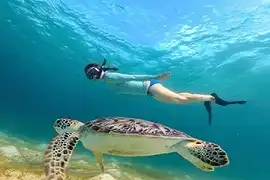




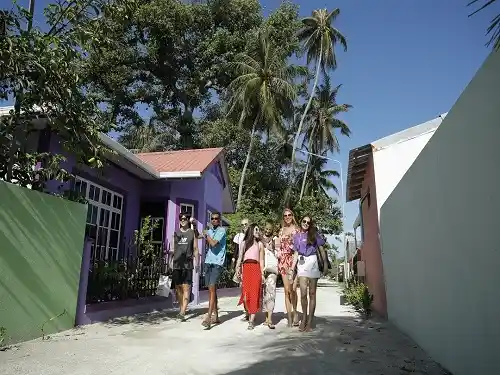





Villingili is home to a vibrant community of approximately 2,000 residents who maintain strong traditional values while adapting to modern influences. The island's population is known for its warm hospitality, sustainable practices, and preservation of authentic Maldivian culture.
Daily life on Villingili follows the rhythm of traditional island routines, centered around fishing, agriculture, prayer times, and community gatherings. Mornings begin early as fishing boats depart before dawn, returning mid-morning with their catch. The island awakens with the call to prayer, followed by a day of work, family responsibilities, and community interactions. The island's larger size and more diverse environment allow for small-scale agriculture alongside traditional fishing, creating a more self-sufficient community than found on many Maldivian islands.
Villingili preserves many traditional Maldivian customs and cultural practices. Religious observances play an important role in community life, with festivals like Eid celebrated enthusiastically. Cultural expressions such as Boduberu performances remain vibrant, while traditional crafts including mat weaving, lacquerwork, and boat building are still practiced by skilled artisans. The island's relative isolation in the southern atolls has helped preserve these traditions with less outside influence than islands closer to Male.
What makes Villingili's community special is its distinct southern atoll identity. The people of Gaafu Alifu Atoll maintain certain cultural practices, linguistic variations, and traditions that differ slightly from northern atolls. This regional identity is a source of pride for residents and offers visitors insights into the cultural diversity within the Maldives. The community's deep connection to their natural environment, particularly the island's unique vegetation and lakes, has shaped local traditions and sustainable practices that continue to this day.
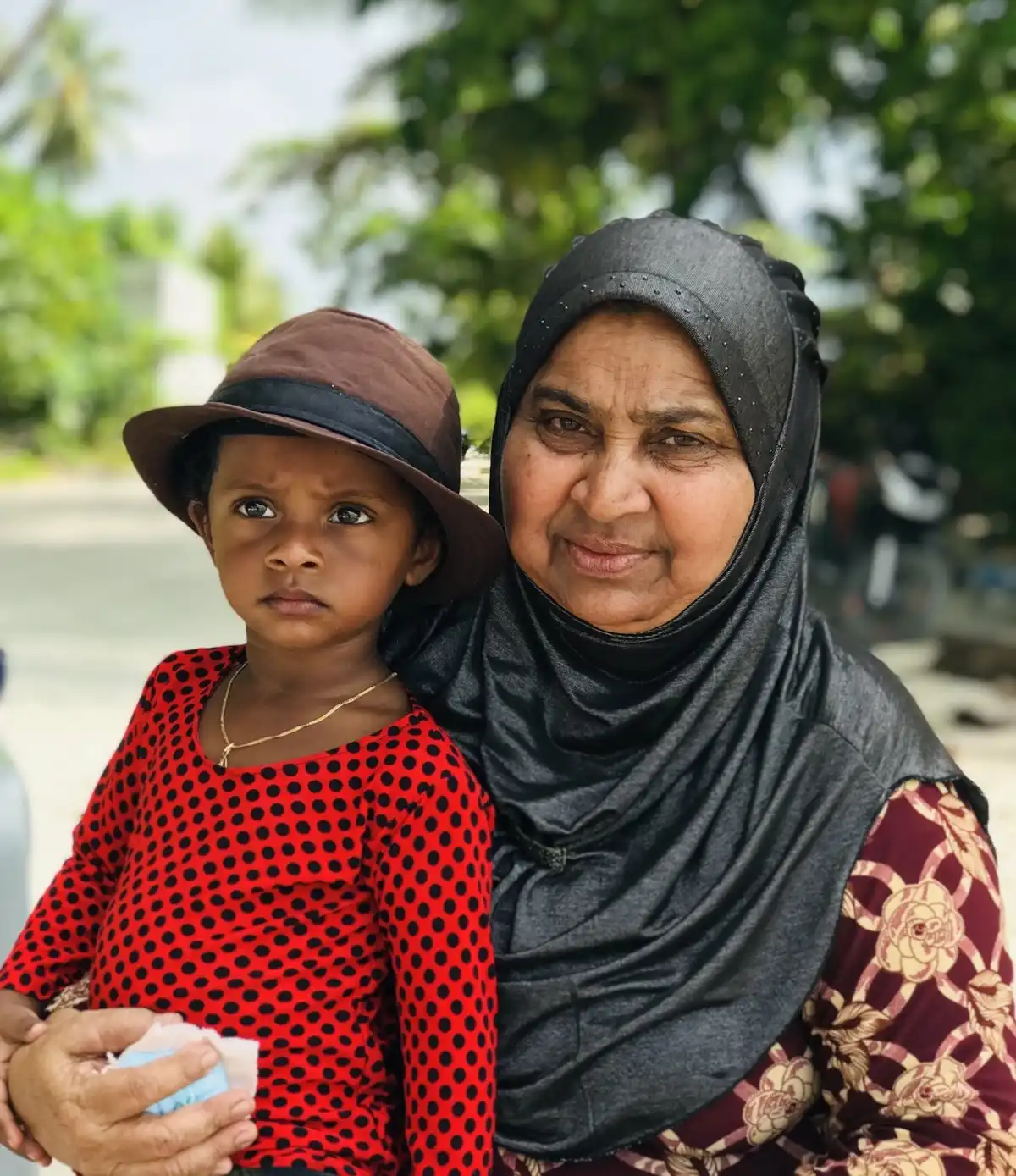

Discover the lush tropical environment, pristine beaches, and authentic island life of Villingili. Book your stay today for an unforgettable experience in Gaafu Alifu Atoll.
Plan Your TripThe most convenient way to reach Villingili is by domestic flight from Male to Kooddoo Airport (60-70 minutes), followed by a 30-minute speedboat transfer. Due to the island's remote location in the southern atolls, direct public ferry services from Male are limited. Most guesthouses can arrange the complete transfer from Male, including the domestic flight and speedboat connection. When planning your journey, remember that weather conditions can occasionally affect flight schedules in this region, so it's advisable to allow buffer days in your travel plans.
Villingili stands out for its unusually lush and diverse vegetation compared to many other Maldivian islands. The island features natural freshwater lakes, a rare phenomenon in the Maldives, which support unique ecosystems and contribute to the island's verdant environment. Towering banyan trees, breadfruit trees, and dense tropical vegetation create natural canopies and shaded areas throughout the island. This rich plant life supports a more diverse bird population than typically found on Maldivian islands. The combination of these features creates a tropical paradise feel that differs significantly from the smaller, less vegetated islands common in the northern atolls. This unique environment allows for activities like nature walks and botanical exploration not possible on many other local islands.
The best time to visit Villingili Island is during the northeast monsoon season (December to April), which brings dry, sunny weather with lower humidity and calmer seas. This period is ideal for water activities, with excellent visibility for snorkeling and diving. The southwest monsoon (May to November) brings occasional rain showers but also lower prices and fewer tourists. Water temperature remains warm (27-30°C/80-86°F) throughout the year. Due to Villingili's southern location, it may experience slightly different weather patterns than northern atolls, with the possibility of brief rain showers even during the dry season. The shoulder months of November and April often offer a good balance of favorable weather and lower visitor numbers.
The waters around Villingili offer exceptional marine biodiversity, even by Maldivian standards. The southern atolls generally feature healthier coral systems than some northern areas, with extensive hard and soft coral formations. Common sightings include reef sharks (blacktip, whitetip, and occasionally grey reef sharks), various ray species including eagle rays and stingrays, and abundant reef fish featuring colorful parrotfish, angelfish, butterflyfish, and triggerfish. The region is known for regular sea turtle encounters, particularly hawksbill and green turtles. The deeper channels in Gaafu Alifu Atoll attract larger pelagic species, with occasional sightings of manta rays, whale sharks (seasonal), and various tuna species. The exceptional water clarity in this southern atoll, often exceeding 30 meters visibility, enhances the snorkeling experience, allowing you to appreciate the underwater world in stunning detail.
Villingili, like other islands in the southern atolls, maintains certain cultural distinctions from northern Maldivian communities. The dialect spoken in Gaafu Alifu Atoll features subtle variations from standard Dhivehi, with unique vocabulary and pronunciation. Traditional crafts in the southern atolls sometimes feature distinctive designs and techniques, reflecting regional artistic traditions. The relative isolation of southern atolls historically meant less external influence, helping preserve certain traditional practices that have evolved elsewhere. The community's relationship with their natural environment, particularly the island's unique vegetation and lakes, has shaped local traditions and sustainable practices. Culinary traditions may include regional specialties and preparation methods not commonly found in northern atolls. While sharing the core elements of Maldivian culture, these regional variations offer visitors insights into the cultural diversity within the country and a chance to experience traditions that may be less common in more frequently visited areas.